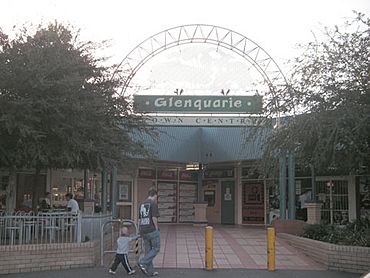Macquarie Fields, New South Wales facts for kids
Quick facts for kids Macquarie FieldsSydney, New South Wales |
|||||||||||||||
|---|---|---|---|---|---|---|---|---|---|---|---|---|---|---|---|

Glenquarie Shopping Centre, Macquarie Fields
|
|||||||||||||||
| Population | 13,714 (2016 census) | ||||||||||||||
| Established | 1883 | ||||||||||||||
| Postcode(s) | 2564 | ||||||||||||||
| Location | 38 km (24 mi) south-west of Sydney | ||||||||||||||
| LGA(s) | Campbelltown | ||||||||||||||
| State electorate(s) | Macquarie Fields | ||||||||||||||
| Federal Division(s) | Werriwa | ||||||||||||||
|
|||||||||||||||
Macquarie Fields is a suburb located in Sydney, New South Wales, Australia. It is about 38 kilometres south-west of the main city centre of Sydney. This area is part of the City of Campbelltown and the wider Macarthur region.
Macquarie Fields is surrounded by natural bushland. Nearby, you'll find Macquarie Links, which is a special housing area next to a golf course. The suburb also has several high schools, like Macquarie Fields High School and James Meehan High School.
Contents
History of Macquarie Fields
The first people to live in the Macquarie Fields area were the Darug people. They are an Aboriginal group from western Sydney. The land here was very fertile, meaning it was great for growing plants. This attracted many animals like kangaroos and emus.
The Darug people ate these animals, along with plants like yams. They lived in small huts called gunyahs. They also made tools for hunting, such as spears and boomerangs. Their culture had a rich system of laws and traditions based on the Dreamtime.
European Settlement and Naming
When the First Fleet arrived in Australia in 1788, British settlers began to take over the land. This pushed the Darug people off their traditional homes.
Macquarie Fields got its name from Lachlan Macquarie, who was the Governor of New South Wales. An early landholder named James Meehan chose the name. Meehan surveyed, or mapped, the area in the early 1800s. He had been sent to Australia as a convict because of his part in the Irish Rebellion of 1798. However, he was a trained surveyor.
In 1803, Meehan became an assistant to the Surveyor-General of NSW. He received a full pardon in 1806 and became Surveyor-General in 1810. For his hard work, he was given large pieces of land, including about 2020 acres in what is now Macquarie Fields. He used this rich land to grow crops like cereals and fruits, and to raise animals.
Growth and Changes Over Time
After James Meehan passed away, his property was sold a few times. In the 1840s, Samuel Terry built a grand house called Macquarie Fields House. This house is still standing today and is considered a historic site.
In 1883, the owner William Phillips divided the land into smaller blocks. He wanted to create a new town called Glenwood Estate with wide streets and fancy buildings. A railway station was added in 1888. However, a tough economic time in the 1890s meant the grand town didn't happen. Only a few small houses were built. During the Great Depression in the 1930s, many people who had lost their homes built temporary shelters here, similar to the early Darug huts.
After World War II, Macquarie Fields started to grow steadily. A public school opened in 1958. By 1971, about 3,700 people lived there. In the mid-1970s, the government built many homes on the east side of town. These areas were named Bunbury (later Guise) and Curran. Some people who owned private homes in Macquarie Fields didn't want these new developments to be part of their suburb. Over time, local leaders have worked to make the whole area feel like one community. More private homes were built, and the town centre grew bigger.
Macquarie Fields in the 21st Century
In 2005, Macquarie Fields experienced a period of community unrest. This followed a serious incident involving a police chase on February 25. The event led to challenges for the community.
Historic Places in Macquarie Fields
Macquarie Fields has some places that are important for their history. These include:
- Quarter Sessions Road: Macquarie Field House
Who Lives in Macquarie Fields?
Based on the 2016 census, 13,714 people call Macquarie Fields home.
- About 4.1% of the people are Aboriginal and Torres Strait Islander people.
- Most people (53.6%) were born in Australia. Other common birthplaces include Bangladesh (5.2%), India (4.3%), and New Zealand (3.0%).
- English is the main language spoken at home for 51.8% of people. Other languages include Bengali (7.1%) and Arabic (4.2%).
- The most common religions are Catholic (19.8%), No Religion (16.3%), and Islam (12.8%).
- Many people work in jobs like office administration, labour, or professional roles.
Getting Around Macquarie Fields
The Macquarie Fields railway station is on the Main Southern railway line. This train line connects Macquarie Fields to other parts of Sydney.
Transit Systems also runs a bus depot in Macquarie Fields. They operate several bus routes that connect the suburb to places like Campbelltown Hospital and Liverpool Station. These routes include:
- 870 Campbelltown Hospital to Liverpool Station
- 871 Campbelltown Hospital to Liverpool Station
- 872 Campbelltown Hospital to Liverpool Station
- 876 Eucalyptus Drive to Macquarie Fields Station
Sports and Fun in Macquarie Fields
Macquarie Fields has a Leisure Centre, which is a great place for sports and recreation. It has an indoor swimming pool and a large outdoor Olympic-sized swimming pool. The centre also has a gym and indoor sports areas.
There are also several sports fields in the town. These include Bensley Road, Hazlet Oval, Monarch Oval, and Third Avenue.
Community Services
Macquarie Fields is home to the WorkVentures Connect Centre. This centre helps people with training and finding jobs.
Famous People From Macquarie Fields
- Brett Emerton is a famous Australian footballer (soccer player). He played 95 games for the Australian national team. He also played for big clubs like Feyenoord in the Netherlands and Blackburn Rovers in England. Brett grew up in Macquarie Fields and played for a local club called Gunners FC.


